How Much Lime To Put On Garden
Using Garden Lime for Healthy Plants
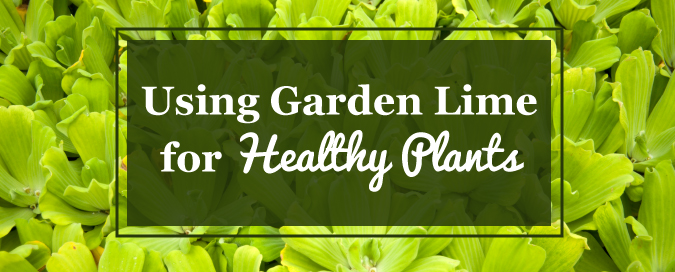
Author/Reviewed By: Josh Miller, Sales Manager: Baker Lime & North America Minerals
Published: 6/12/2015 – Updated: 7/23/2021
There are few things more rewarding than growing delicious vegetables and eating them when they're at their ripest. Unfortunately, gardening isn't always simple and, sometimes, you have to leave your garden up to nature. Many experienced gardeners will even tell you that they've struggled to yield a good crop at one point in time.
Pick up any gardening book or magazine, and you'll likely see the word "lime." Reading these publications may make it seem like lime is the magic solution to all of your garden's problems. But just what is lime, and what does garden lime do?
Video – Benefits of Using Lime in Your Garden Soil
When correctly applied, lime works to increase the pH of acidic soil. This creates a healthier base for plants to grow, because they'll now have access to the nutrients and minerals they need to thrive. Garden lime is a powdered or pelletized product made from naturally occurring minerals. It has been used safely in agriculture for over a thousand years to change the soil pH, making it easier for plants to take up minerals and nutrients from the soil.
Lime also promotes the spread of new, good bacteria in your garden by supplying critical nutrients like phosphorus and zinc in your soil. Limestone also enables you to fertilize your garden more effectively, which means you won't have to spend a lot of money to have a beautiful garden. To help your garden reach its full potential, apply garden limestone to your soil.
If you slept through high school biology and chemistry, don't worry. Modern soil tests conducted at your local garden center or Cooperative Extension office can help you understand your soil's pH level and whether or not you need to adjust it to grow a lawn, flowers or a vegetable garden. Commercial lime products, such as pelletized lime, make it easy to add just the right amount to adjust soil pH levels.
Where Does Lime Come From?
Garden lime is mined from deposits formed millions of years ago. During that time, shallow seas covered much of the Earth, and prehistoric sea creatures lived in those waters. The creatures' shells, composed largely of calcium, formed the deposits known today as limestone.
Using lime in the garden is one of the earliest known gardening techniques. For centuries, farmers have been transforming limestone and other rocks into lime powder to spread on their gardens and farms. In years past, they may not have known exactly what magic worked under the soil, but today, we know lime does several beneficial things to the soil. Lime is great for:
- Raising soil pH, which is necessary in many parts of the agricultural world to grow crops in acidic soils near human habitation.
- Adjusting the soil pH to grow a wide range of crops that people may not have been able to grow in that area before.
- Adding calcium and magnesium to the soil, two elements needed for vegetable and flower production. A lack of these minerals can cause malformed vegetables, poor fruit set or dropped fruits and vegetables.
- Making nutrients more readily available to plants, especially nitrogen, an essential nutrient that helps plants grow.
- Helping herbicides work more efficiently.
- Aiding beneficial soil bacteria and microbes, which improve the health of your garden soil.
Among all the amendments you'll want to buy for your garden, lime materials are among the best things you can bring in. Knowing how much to add, when to add fertilizer to a garden, the type of lime to buy for your garden needs, and asking the important questions like "can hydrated lime be used in the garden" or "when is the best time to apply lime" can help you garden more efficiently and effectively.
Understanding Garden Soil pH
Before learning more about lime and garden lime uses, it's important to understand a basic chemistry concept called pH level. The pH scale measures hydrogen ions on a scale ranging from 0 to 14. You've probably heard the terms acid and alkaline. Those terms refer to the far extremes of the scale, with 0 being a pure acid and 14 being a pure alkaline. The midpoint, 7, is called neutral.
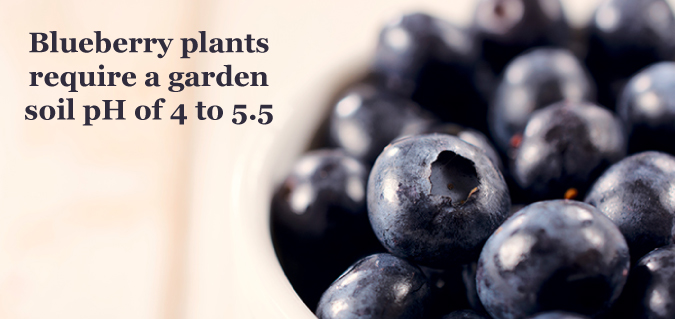
Most living organisms prefer a pH somewhere near the neutral portion of the range, although variations aren't uncommon. Among plants, different plants prefer different soil pH, depending on where the species evolved.
Blueberry plants, for instance, evolved in the acidic soils of rocky, cold areas, and so they require a garden soil pH of 4 to 5.5 for best production. Blueberries are an extremely acid-loving plant so you may be looking at how to make garden soil more acidic. On the opposite end of the spectrum are vegetables such as asparagus, which can tolerate an extremely alkaline soil pH of up to 8.0, almost unheard of among vegetables.
Most gardening books recommend that vegetable garden soil offers plants a pH of 5.5 to 6.5. This range creates the ideal conditions under which vegetable plants can absorb nutrients and trace minerals through their root system. Complex soil bacteria and fungi attached to the root systems of plants and found in colonies throughout the soil break down organic matter into its components. Water then transfers those components to the plant's roots. If the soil pH is within the appropriate level for your vegetable plants, they can absorb these nutrients easily and effectively.
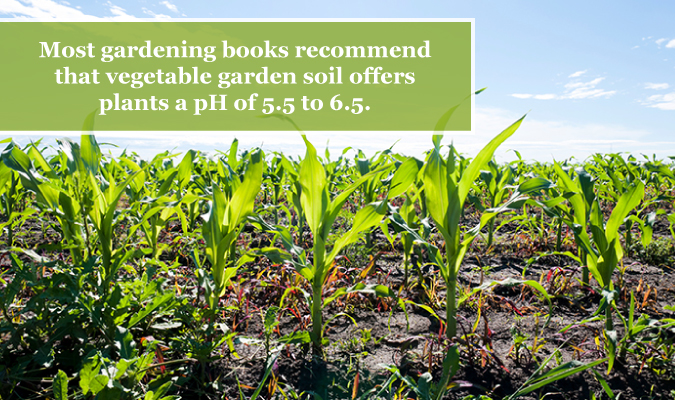
When the soil pH isn't within a usable range for a plant species, diseases occur. For example, blossom end rot, a problem in tomatoes, occurs for many reasons, but one important reason is improper soil pH. When soil pH is too low or too high for tomatoes, they can't absorb calcium, an important mineral necessary for good fruit development. Black, flat spots called blossom end rot then develop in the tomatoes.
Adding lime to change the soil pH as well as adding simple organic materials, such as a sprinkle of Epsom salts (magnesium sulfate), makes the calcium and magnesium in the soil available to the tomato plants. They can then effectively use these minerals to produce an abundance of quality tomatoes. As you can see, what goes on in the soil, even at the microscopic chemical level, directly affects the health and productivity of your vegetable garden. Learn more about pH levels, pH test kits and the soil test results.
The Importance of Soil Maps and Soil Testing for Gardening
The United States Department of Agriculture has actually produced soil maps showing the general soil types found throughout the United States. It's a great place to start if you want to understand the basic structure of the soil in your area. Soil maps will help you understand whether your part of the country generally has an acidic or alkaline soil, and you'll find the type of soil (clay, loam or sand) you'll most likely see in your county.
Once you have an overview of the soil in your area, it's time to get a soil test done to know the exact pH level of your garden soil. Not sure if you should add lime to your garden? The only way to know for sure whether or not your garden needs lime is to have a professional soil test completed.
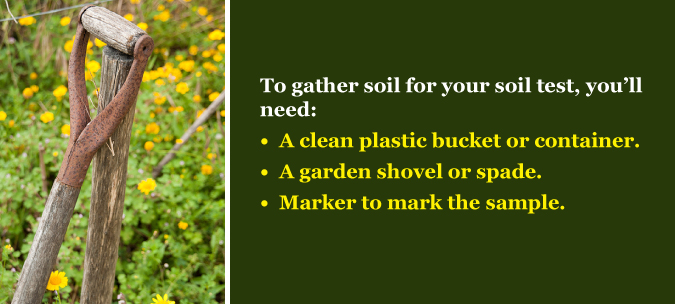
Dig your soil sample from the area where you want to plant your vegetable garden, flowers or lawn. Dig up about half a cup of soil from approximately four to six inches below ground level. Take several samples and mix them together in your container. Label the container and bring it to the lab.
When you're conducting soil tests, keep the following in mind:
- Conduct a soil test at least three months before you intend to plant in the area. This gives you plenty of time to have the test completed, analyze the soil test results, and to add anything recommended by the test, such as garden lime or fertilizer.
- Only use samples from among holes dug in a single-use area. For instance, if you're planting both a lawn and a vegetable garden, don't mix soil samples from the lawn area with those from the vegetable garden area. You want only vegetable garden soil in one sample and lawn soil in another.
- If you're recycling a bucket or container to use for your soil test, clean and dry it thoroughly before adding soil samples to it. Any residual chemicals can affect the test readings.
- Use only plastic or glass containers. Metal can change the soilt test results.
- Tell the person conducting the soil test what you intend to plant in the area from where you've drawn the soil sample. They may recommend different amounts of lime to adjust the soil pH based on what you intend to grow. You may need to lower or raise the pH of your soil.
Even if you've had your garden soil tested in previous years, it's a good idea to get it tested each year in early spring. Adding commercial fertilizers to the garden can acidify the soil, changing the pH and pushing it outside healthy levels to grow your garden. Testing garden soil before adding lime and other amendments ensures you're adding the right amount.
When to Apply Garden Lime
Some experts recommend adding lime to your garden at the end of the growing season to give it enough time to work through the soil. Lime needs time to react with water in order to be beneficial to your garden plants, so at the very least, it needs several weeks or months to adjust the pH and help make more nutrients available to your plants.
If you get your soil tested at the end of the winter, add lime immediately as recommended by the test results. Lime works best when mixed or tilled into the soil at the depth in which your garden will be planted — so don't just spread lime on the surface of the vegetable garden and hope it works. Mix it into the soil well before your frost-free date indicates you can plant your vegetables or flowers.
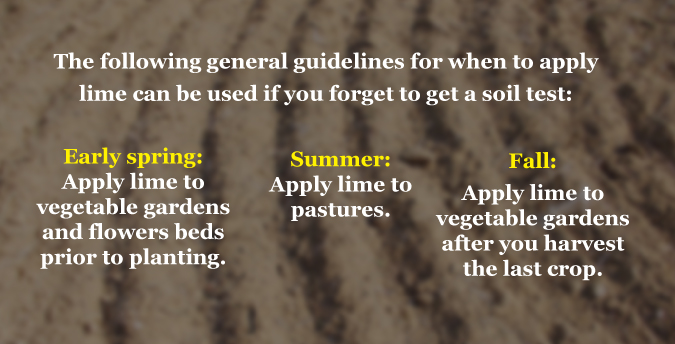
Gardens found in acidic soil areas benefit from annual or bi-annual applications of garden lime. Raised bed gardens may get away with fewer applications. A soil test, however, is the best way to tell whether or not it is time to apply garden lime.
How Much Lime to Apply to Gardens
The results of your garden's soil test will help you determine how much lime to apply. You'll need to know your soil's starting pH and the composition or soil structure. Soil generally falls into three categories:
- Clay soil: This soil type is characterized by tiny soil particles that stick together, making drainage difficult. Clay soil may dry into hard sheets that are tough to work with or dig into. It may have plenty of nutrients for plants, but the plant's roots have a hard time breaking through the tiny particles to get to them.
- Sand: Sandy soil has the largest particle sizes and the lowest amount of nutrients. Water drains away rapidly through sandy soil.
- Loam: Loamy soil is the ideal soil type. Loam soil is an equal mix of clay, sand and organic material that forms a rich soil base that almost all plants love. Very few gardens naturally have loamy soil, but loam can be created from other soil types through the careful application of compost and other organic materials.
To determine how much lime to add to your garden, first examine your soil or the previously mentioned soil maps to see what kind of garden soil you're working with. If you're not sure, you can do a simple soil structure test at home:
- Take a glass or plastic jar like an empty, clean jelly jar or mayonnaise jar with a screw top lid.
- Place about one cup of garden soil into the jar and fill the jar with water.
- Screw the lid onto the jar and shake the mixture for 30 seconds.
- Set the jar down and wait five minutes.
Here's what the results can tell you:
- If the water is clear and most of the soil settled back onto the bottom of the jar, you have sandy or sandy loam soil.
- If the soil particles remain in suspension and the water looks murky and cloudy after five minutes, you most likely have clay soil. The tiny clay particles remain suspended in water much longer than sandy or loam soil.
Another way to test your soil is to scoop up about a tablespoon of garden soil into the palm of your hand. Add a few ounces of water and roll the soil to form a ball. The less water you need to form a ball, the higher the clay content. If the soil never forms a ball at all, it's very high in sand content. The bigger sand particles don't cling together the way tiny clay particles do in water.
Now that you know your garden's approximate soil composition, here's how to estimate garden lime needs. All figures are taken from Cornell University's Cooperative Extension site. The following information will help you raise your garden soil pH to 6.5 for a vegetable garden. The amount of lime in the "Add" column is for 100 square feet of garden soil and assumes it will be mixed into the soil.
Using Limestone for Gardening
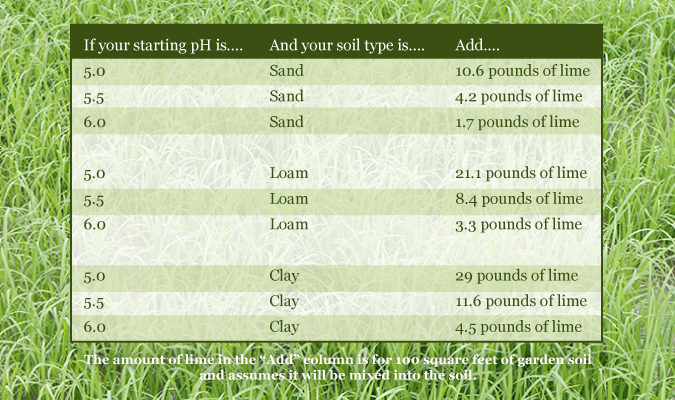
Types of Lime for the Garden
There are many types of lime available at the store, but the best ones to use for your vegetable or flower gardens are pelletized lime and powdered lime:
- Pelletized lime: Pelletized lime is evenly sized pellets of lime. It's very easy to spread, especially on lawns. You can apply it to the surface, and it is activated by water.
- Powdered lime: There are different types of powdered lime. Each uses a different type of agricultural spreader to evenly distribute lime at the surface where it can be tilled into the soil.
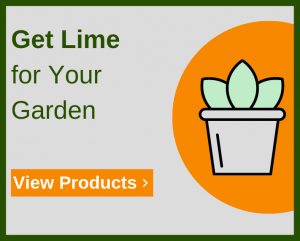
Lime is usually sold in large bags or sacks. It should be kept dry until you are ready for lime application, so store it in a garage or shed. Water can penetrate the sack and dissolve the lime, making it unusable.
How to Apply Lime to Your Garden
Most home gardeners use a lime or drop spreader to spread powdered lime on lawns and gardens. A lime spreader is a machine you walk behind and push. It has a hopper in the front that you fill with powdered lime. A spreader then sprays out the powder in even amounts as you push the machine forward.
To apply lime to lawns, fill the lime spreader with the appropriate amount of lime. Walk in a straight line, making sure to spread the lime in the same direction with each pass of the spreader to avoid a 'checkerboard' look to the lawn.
Lime for garden soil can also be scattered using a spreader. If you don't want to use a spreader, however, you can use a shovel to spread lime over the soil surface.
The lime should be tilled or dug into garden soil to mix it in so it's more readily available to your garden plants. Mix it into the soil at a depth of about four to six inches. Lime applied to the soil's surface will drip down about four inches after several rainstorms, but tilling or mixing it in makes it work faster at the root level where it can be of most benefit.
Lime needs water to mix into the soil and become available to plants. It's not a quick fix. You won't see your lawn turn a rich, emerald green after applying lime. Think of lime like vitamins for the soil. When you take a vitamin pill, you're taking vitamins to boost your long-term health, not for quick energy. Adding lime to the soil is like a vitamin. It's for the long-term health of the soil and your plants.
The Benefits of Lime for Lawns
Lime can be very beneficial for lawns. Lawns that have yellow patches, brown patches, weedy areas or an abundance of moss may benefit from an even application of lime. Weeds or mossy patches can both be signs that the pH of specific areas on the lawn differ from the overall pH of the lawn. Moss, for example, grows in acidic conditions — which can be improved by the addition of lime.
Adding lime to your lawn also does more than just raising the soil pH. Lime also adds calcium, which in turn helps grass absorb trace elements such as zinc, copper and others. By adding lime, you'll boost the overall health of your lawn. An even spread of lime can correct many deficiencies and adjust the pH of the lawn over the growing season so the problems disappear.
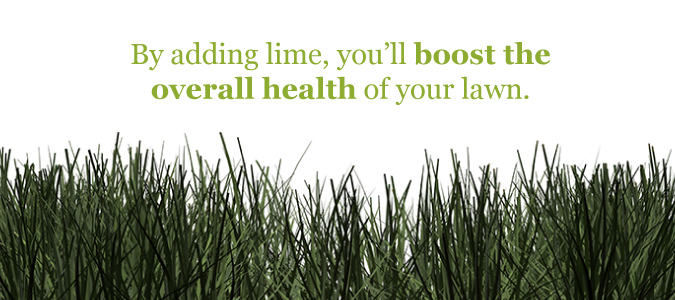
Apply lime to lawns in the fall. Rain and cool temperatures help lime move into the soil. It can take up to two years to see a benefit from adding lime to the soil since it moves slowly from the surface to the roots, but don't overdo lime application.
What Vegetables Like Lime?
Depending on your soil, you may need to add lime throughout the vegetable garden. Some plants love a little extra lime because they prefer "sweeter" soils, or soils with a slightly more alkaline quality to them. Remember that adding lime raises the pH level of the soil.
Pay particular attention to beds where the following vegetables and fruits will be grown to ensure proper plant nutrients:
- Lime for tomatoes: Lime for tomatoes is almost a given in most garden soil. Soils that are even slightly too acidic won't produce good quality tomatoes and will bind calcium and magnesium into the soil where plants cannot access it. Lime changes the soil pH to make those nutrients accessible to tomatoes, preventing blossom end rot and premature tomato drop. Lime for tomatoes is a good idea. Tomatoes need soil pH from 5.5 to 7.5.
- Lime for soybeans: Adding lime to fields prior to planting soybeans is also an excellent idea. Lime for soybeans also includes all legumes which prefer a more alkaline soil. Some growers claim that lime can even double a soybean crop yield.
- Lime for squash: Both winter and summer squash love soil that's slightly more alkaline, with tolerance levels of up to 7.0 for soil pH. Adding lime to most soils improves squash plant yields.
- Lime for asparagus: Among the list of common garden vegetables, asparagus is probably the one that loves lime the most. Lime for asparagus is necessary to give the plant the 'sweet' alkaline soil it craves. Asparagus only needs a slightly alkaline soil, but it can tolerate soil pH up to 8.0. Because asparagus plants are left in the garden year-round, and an asparagus bed produces more crop the older it is, you may need to add a slow-release lime that's gentle on plants. Pelletized lime offers a good option.
- Lime for cantaloupe: If you plan to grow cantaloupe, adding lime can also improve the amount and flavor of the melons. Cantaloupe prefers a soil pH of 6.0 to 7.5, leaning toward the alkaline side. Lime for cantaloupe raises soil pH to the alkaline level.
- Lime for onions: Lime for onions raises the soil pH to between 6.0 and 7.0, which is what onions prefer in order to develop large, tasty bulbs.
- Lime for parsnips: Parsnips need a long growing season, so when adding lime for parsnips, add it in the early spring and again after harvesting parsnips in the late fall. Soil pH for parsnips should be between 5.5 and 7.5.
- Lime for lettuce: Almost all lettuce varieties benefit from a little lime, and lime for lettuce can help your plants develop strong, tasty leaves. Lettuce needs a soil pH between 6.0 and 7.0.
Which Plants Don't Like Lime?
Any plants considered "acid-loving" plants shouldn't be given extra lime. This includes blueberries as well as ornamental shrubs such as azaleas, rhododendrons and hollies.
If you're adding garden lime to a flower bed where azaleas and other acid-loving plants are located, keep the lime away from the roots of the plant. Remember that the roots extend out under the soil in an umbrella-like shape under the ground. The drip line, or the imaginary line around the shrub where the leaves extend in a circle, is the line underground where the roots grow.
When you're not sure about which plants like lime and which don't, look them up online or in a good reference book.
Can Plants Have a Lime Deficiency?
Plants don't need lime to survive, but they do need the trace minerals that often accompany lime, such as calcium and magnesium. They also need the soil pH to be within an acceptable range for their species so they can absorb these minerals and other elements from the soil for growth and development.
Plants that suffer from a nutrient deficiency may benefit from lime added to the soil. It's hard to tell whether a problem is caused by nutrient deficiency, horticultural practices, microorganisms or insects, but you can spot nutrient deficiencies in vegetables and other plants by these symptoms:
- Distorted, misshapen leaves.
- Leaves that are yellow or turn yellow over time.
- Poor production of vegetables.
- Vegetables or fruit fall off the plant prematurely.
- Plant appears stunted or fails to thrive.
While adding lime may not cure nutrient deficiencies, combining it with a good-quality fertilizer containing trace elements of essential nutrients can help. Because lime changes the soil pH, it can make the nutrients more readily available to the plants, and the fertilizer can provide the extra nutrients plants may need. Over time, the plant can correct the nutrient imbalances.
If you're not sure what's causing your plant problems, consult your local Cooperative Extension office or take a sample of your plant to your local garden center for diagnosis and assistance.
What to Do If You Use Too Much Lime in Your Garden
You know the old saying, "You can never have too much of a good thing?" Well, you can have too much lime. Sometimes you just get overzealous with the spreader. Other times, a bag will break as you're hauling it out to the garden, dumping lime everywhere. What should you do if you use too much lime on your lawn or garden?
First, if it's on your lawn or another area where you can scoop it up, scoop up as much scattered lime as you can. If you've actually mixed it into the soil before you realized you added too much, don't panic. There's still a few things you can do to help.
Lime raises soil pH, but the following amendments lower soil pH. If you've added too much lime, the following can swing the pH balance back to the acidic side:
- Sulfur: Garden sulfur or elemental sulfur is one of the most effective treatments for alkaline soil. Soil bacteria feed on the sulfur and lower soil pH in the process. Sulfur is spread or mixed as a powder into the soil, and you can often find small bags of it at the garden center. Be sure to check with the garden center or your local Cooperative Extension office for application rates. These rates depend on how much lime you accidentally added to the soil and how low you need your pH level to go.
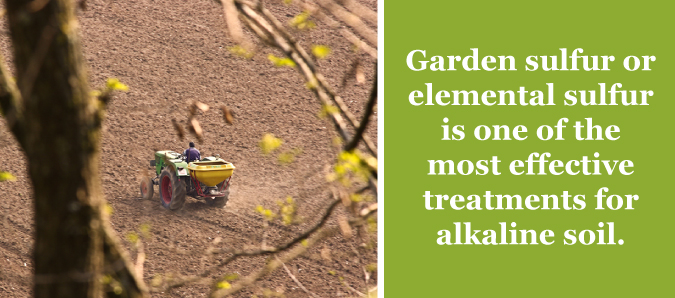
- Peat moss: Some gardeners don't like the recommendation to use peat moss because it is harvested from ancient deposits that once depleted are gone for good. But peat moss is one of the most effective organic garden acidifiers. It's expensive, but it works well to both lower pH and improve soil texture. You can purchase it in large bales or bags and mix it into the soil. It won't harm plants, and it will improve drainage in clay soils.
- Manure: Manure is a little tricky to use because you will need to make sure you use well-rotted or composted manure in the garden. Animal manure such as cow, horse, sheep, rabbit and goat manure makes a fine garden soil amendment, adding both nutrients and acidity to the soil. It can counteract excessively alkaline soils or the effects of too much lime added to the soil. You can often find free sources of composting manure from local horse stables, but be sure to let it sit and rot for a while before adding it to the soil.Under no circumstances should you ever use manure from carnivores such as dogs, cats, pigs or similar animals. Such manure can harbor harmful bacteria and parasites.
- Compost: Compost isn't strictly a soil acidifier, but it's so good for your garden soil that it must be mentioned. It has a slightly acidifying effect on the soil, especially if it's made from a higher balance of leaf matter than other garden debris.
Compost improves soil fertility and health, adds beneficial microbes and balances pH that's slightly off if you've added just a little too much lime. Since you can't overdo the compost, add as much as you want — as long as it is well-rotted and mixed into the soil prior to planting. Well-rotted compost smells sweet and has the look of crumbled chocolate cake.
Garden lime will "keep" for next year if you've purchased a little more than you need. Store it in a cool, dry place like a shed or garage. Stack bags of lime on pallets, blocks or bricks to keep it off of a concrete floor so the bags do not get damp.
Be Smart When Adding Lime to the Garden
Buying garden lime, such as lime from Baker Lime, can be very helpful in the home garden. But before adding lime, make sure you get a soil test to see how much you actually need. You may be pleasantly surprised and need less than you thought you did. Or, you may need more.
Excess lime usually dissolves into the soil, but the effects can last for a long time. That's another great reason to know exactly how much lime to add to your garden soil before spreading it.
If you're constantly battling against acidic soil, you may wish to investigate growing a raised bed vegetable garden. Raised beds provide you with a controlled planting area you can more easily amend than an in-ground garden. In addition, when you start with bagged garden soil, your vegetable garden will begin with soil that's better than what you may have available naturally.
Raised bed gardens can also be ideal for people living in areas with poor soil or on land that's been heavily farmed or planted with pine trees — which turn soil very acidic. You will still need to check the soil pH each year and add lime as needed, but probably not as much.
Your plants know what they need, so work with nature and not against it when you're planning your garden. If your soil is naturally acidic, choose plants that thrive in a lower pH soil. Even when adding plenty of good-quality lime products from Baker Lime to the soil, you may still struggle to keep the pH high enough to satisfy alkaline soil-loving vegetables, like asparagus, if your soil is naturally sour or acidic.
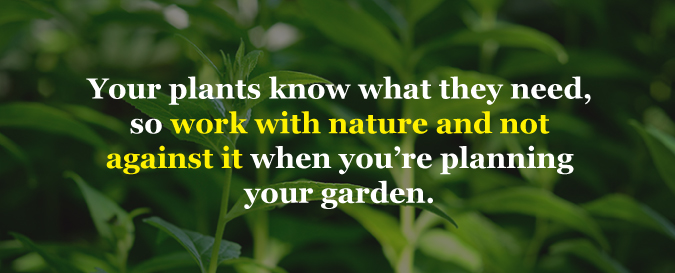
Most vegetables, however, are tolerant of a wide range of soil pHs and conditions. If you've tried to grow certain vegetables and didn't have much luck, adding lime may improve your chances of a good harvest.
Where Can I Buy Garden Lime?
If you need lime for your garden, you've come to the right place. Since 1889, Baker Lime has supplied farmers, landscapers and homeowners with high-quality lime mined from our own dolomite deposits in the heart of York County, PA. As one of the most well-known and trusted lime suppliers on the East Coast, we supply customers in New York, Pennsylvania, Delaware, West Virginia, Virginia, New Jersey, Maryland and beyond. You can request a quote online.
For over 125 years, we have built our reputation on providing our industrial, commercial and residential customers with the limestone products they need to transform their gardens. As you search for limestone for your garden, our friendly staff can answer your questions and provide free quotes! Contact us today to find the limestone you need at the best value.
Our lime can help your garden and lawn flourish, diminish plant problems and improve the quality and quantity of vegetables and fruits. It also adds to the health of your soil, helps plants absorb nutrients and is an all-natural product from American sources.
For more information or to obtain a price quote from Baker Lime, find and contact your local dealer today.
Related Resources
- How to Measure Soil pH
- Should You Apply Lime or Fertilizer First?
- Using Lime for Food Plots
- Liming FAQ
How Much Lime To Put On Garden
Source: https://www.bakerlime.com/garden-lime/
Posted by: rogersocke2001.blogspot.com

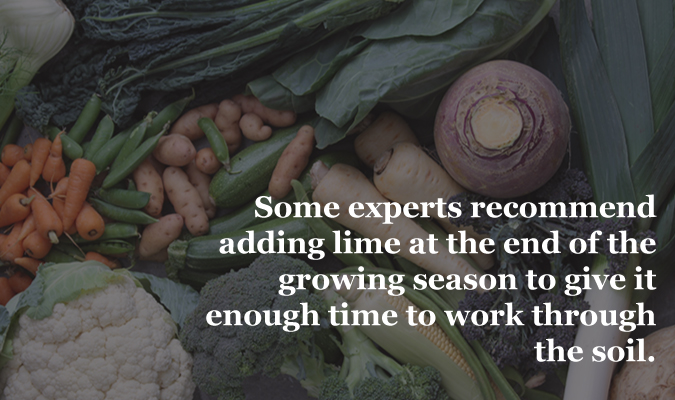
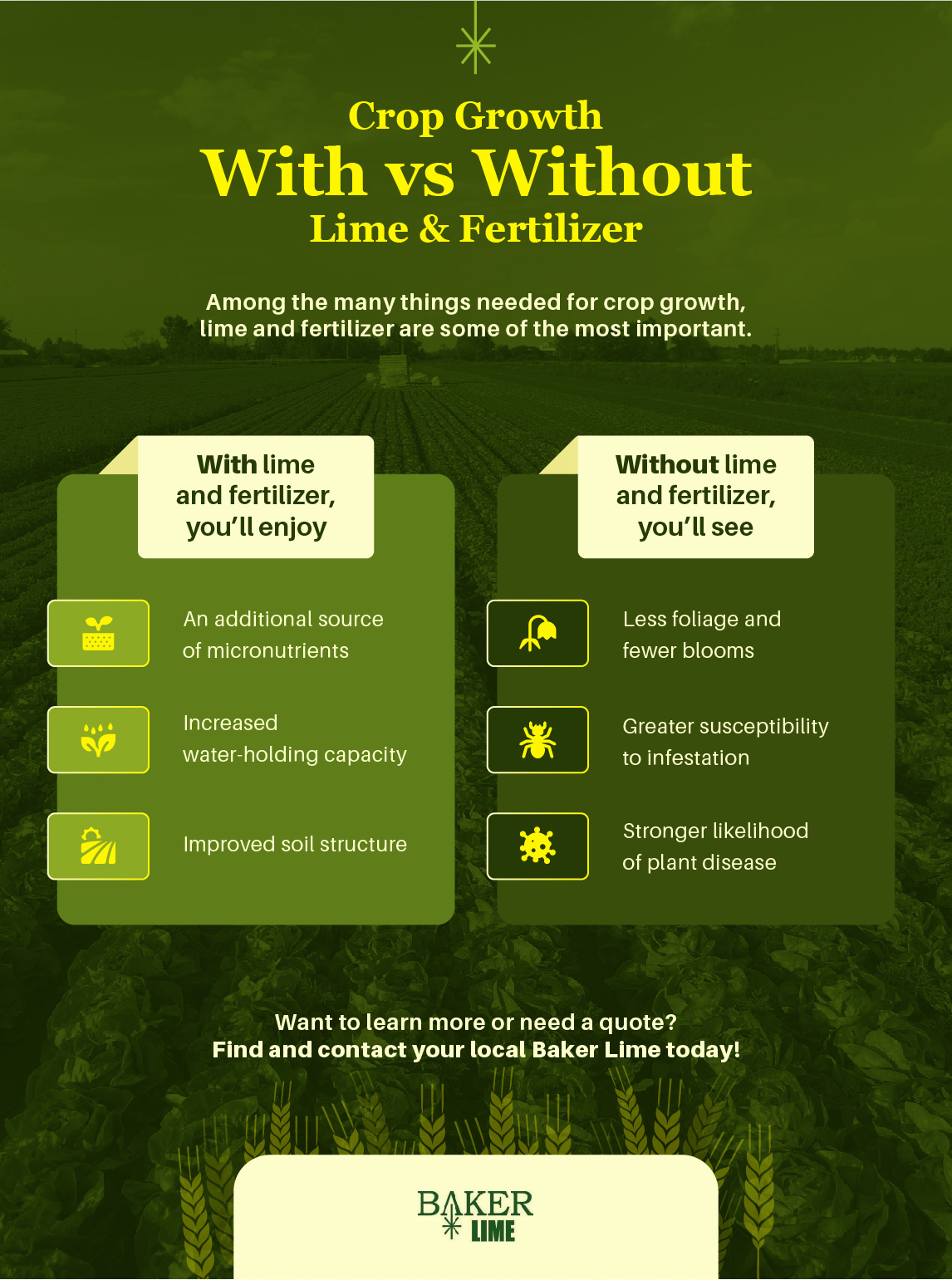
0 Response to "How Much Lime To Put On Garden"
Post a Comment